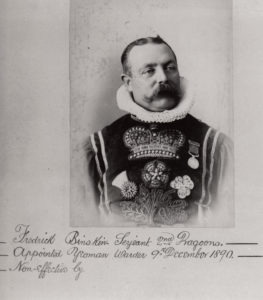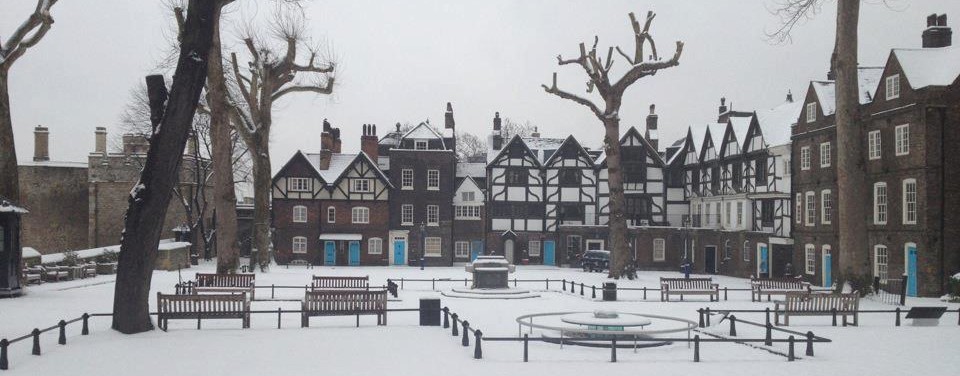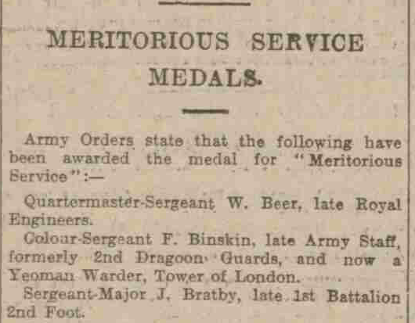Frederick was a Yeoman Warder here at the Tower from 1890 to 1920.
 Frederick was born in the parish of Saint Paul’s Maidstone, Kent, in July 1846 and, enlisted on the 25 July 1865, at the age of 19, for 12 years service with the 2nd Dragoon Guards at London.
Frederick was born in the parish of Saint Paul’s Maidstone, Kent, in July 1846 and, enlisted on the 25 July 1865, at the age of 19, for 12 years service with the 2nd Dragoon Guards at London.
For this he received a bounty of £1 with a free kit for enlisting. He gave his trade as labourer, and he gave his residence as the Parish of St. Margaret’s , Middlesex.
He stood 5ft 9in tall, weighed 15 pounds, Brown hair.
He was recruited by Sergeant James Green of the Queen’s Bays.
Binskin, was attested for 12 years with the colours at Westminster Police Court on the 25th July 1865, he was examined by a staff surgeon major of the 30th Foot and found fit for service, and revaccinated with ‘Perfect’ results.
On the 29th July 1865 he joined the Cavalry Depot at Canterbury for recruit drill and riding school, as a Trooper in the 2nd Dragoon Guards, his army number 1050. Although his regiment were drafted to help quell the Great Indian Mutiny, he remained at the cavalry depot until March 1870.
- 19 September 1865, He was admitted into Hospital for 16 days for the treatment of Bronchitis.
- 6th August 1866, He was admitted into hospital for 10 days for the treatment of Vesic Penis
- 26th August 1866, He was admitted into hospital for 8 days for the treatment of the same social disease.
- 21 February 1867, He was promoted to Corporal.
- 8 March 1867, He was admitted into hospital for 7 days for the treatment of Bronchitis
- 18 July 1867, He was admitted into hospital for 7 days for treatment.
- 27 July 1867, He was granted Good Conduct pay at 1d.
- 26 July 1868, He was admitted into hospital for 9 days for the treatment of Lumbago.
- 27 July 1868, He was admitted into hospital for 36 days for the treatment of an eye contusion, the result of a blow.
31 December 1869, The 2nd Dragoon Guards, departed India after 12 years service, on HMS Malabar, a Euphrates-class troopship launched in 1866, and the fifth ship of the Royal Navy to employ the name. She was designed to carry troops between the United Kingdom and British India, and was employed in that role for most of her life. She became the base ship in Bermuda in 1897, was renamed HMS Terror in 1901 and was sold in 1918.
Her name was later used for part of the Royal Dockyard in Bermuda. From 22 March 1867 13 February 1870 its Captain was a Frederic Dampier Rich.
They sailed the overland route, from Suez by Cairo to Alexandria via rail, then boarded another ship which then landed in Portsmouth on the 31 August 1870. The 2nd Dragoon Guards Regiment had a total of 483 all ranks, with 300 bay troop Horses, they then camped for a few weeks at Chichester, Sussex, before moving to their new deport at Colchester, Essex.
In March 1870, The now Corporal Binskin moved from the Cavalry Depot Canterbury to the new home of the 2nd Dragoon Guards, Colchester, he would have served some 5 years and this would be the first time he would have see his Regiment.
8 July 1870, He was kicked by a horse in the riding school, suffering a severe leg injury. A compound fracture to his right Tibia in the upper third of the bone, with a simple fracture of the right fibula in the same location.
16 September 1870, The Bay were inspected by F.M. the Duke of Cambridge, Commander-in-Chief, who reported the Bays were.
‘in better order and condition than any cavalry regiment he had seen since its return from India’.
- 7 December 1870, He was promoted to Sergeant.
- 27 July 1871, He was granted good conduct pay of 2d.
- 3 August 1871, Again into hospital for 7 days treatment for a contusion to his leg, a result of a horse falling on him.
- 31 August 1871, Binskin, moved with the 2nd Dragoon Guards, moved to the East Cavalry Barracks, Aldershot.
- 3 September 1871, To hospital for 5 days treatment for a contusion, after a horse fell on him.
- 20 September 1872, Binskin, was detached with a Squadron of the 2nd Dragoon Guards, to Woolwich.
- 2 July 1873, They then moved to Brighton.
- 18 October 1873, was admitted to hospital for 22 days treatment for acute rheumatism.
- 22 October 1873, He was re-vaccinated again with ‘Perfect’ results by Frederick Moore, the Squadron Major, of the 2nd Dragoon Guards.
- 13 July 1874, Binskin moved with a Squadron Detachment to be stationed at Preston.
- 25 July 1875, The 2nd Dragoon Guards were posted to Newbridge, Ireland, although Binskin remined in Preston, and re-joined the Regiment in Ireland in March 1877.
- 5 March 1877, Sergeant Binskin, Stationed Caher, Ireland, where he rejoined the Regiment.
- 8 March 1877, Binskin, re-engaged at Caher, Ireland to complete 21 years service with the colours,
- 27 July 1877, Binskin is entitled to the Three Year Good Conduct Badge.
- 9 September 1878, Binskin with the 2nd Dragoon Guards moved to Station Dublin.
- 3 August 1879, Sergeant Binskin married Bessie Evans, a spinster, in All Saints Church, Knightsbridge.
- 12 May 1880, Binskin with The 2nd Dragoon Guards station at Dundalk, Co Louth
- October 1880 The 2nd Dragoon Guards moved to back to the UK, to Manchester and Liverpool although Binskin, stayed in Ireland and moved back to the UK at a later date.
- 27 May 1881, Sergeant Binskin, was posted to Longford.
- 27 July 1881, Benskin became entitles to 4 good conduct badges.
1 October 1883, Binskin was then recommended by the Officer Commanding of the 2nd DG for the Silver Long Service and Good Conduct Medal (LS&GC).
12 June 1886, Binskin was transfered to the Staff of the Army, on the Recruiting Service, per authority of H.G. letter No. 104, War Office, Home District. The Home District of the staff of the Army was Headquartered at Horse Guards, London. It comprised Berkshire (Not Aldershot District), Buckinghamshire, the City of London, Middlesex, Oxfordshire, Surrey and Tower Hamlets. To this date, Binskin had served 19 Years and 324 days with the colours.
- 9 July 1886, Good Conduct pay at 5d
- 16 June 1888, Promoted to Colour Sergeant.
30 July 1889, Colour Sergeant Frederick Robert Binskin, was discharged from the staff of the Army in London at his own request, having completed 24 years and 4 days with the colours, all at home service, no service overseas.
He had qualified for a second class certificate of education during his service, and his character on discharge was ‘exemplary’.
9 December 1890, Frederick R Binskin, was appointed as a Yeoman Warder replacing Robert Sheppard (65), to his death 1 August 1920, when he was replaced by Yeoman Warder Edward Early (186).
He had the following medals:
- 1897 Jubilee Medal
- 1902 Coronation
- 1911 Coronation and
- The Long Service and Good Conduct Medal LS and GC Medals (this last was awarded in 1883 and has been sold separately).
- Meritorious Service Medal awarded as Yeoman Warder 1st February 1915 without annuity.
He was at the Tower of London during WW1, and was then shown on the MSM Register as late Staff of the Army.
He is buried with his wife Bessie Evans, at Bexley Heath plot 101
In his will he left a 15 acre field at Dymchurch, Kent, his freehold home, ‘Delta House’, on Methuen Road, Bexley Heath, another freehold house, ‘The Nest’, on Methuen Road and six houses on Dymchurch Terrace, Nos. 3, 5,7, 9, 11 and 13. He had shares in Mackeson’s Brewery, War Saving Certificates and Bank holdings.
He also left paintings of himself as a Warder and as a Dragoon Guardsman.


Leave a reply to Yeoman Warder Frederick Robert Binskin 130